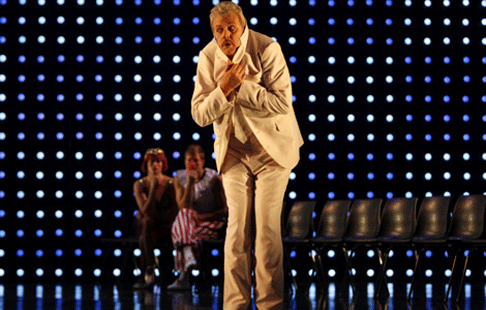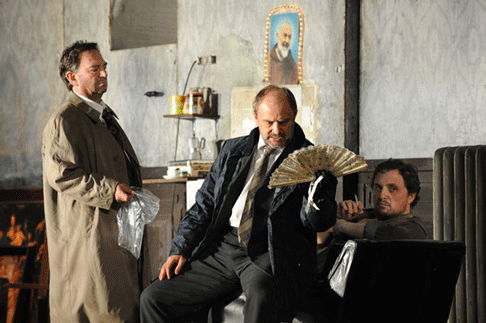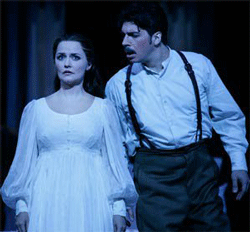One, The Eighth Wonder, even dealt with the creation of Opera
Australia’s main venue, the Sydney Opera House.
Bliss
The most recent commission Bliss, is by Brett Dean and based on the
novel of the same name by one of Australia’s most celebrated living
authors, Peter Carey. Unusually it is not a serious historical work, instead it
is a grotesque satire on the Australian Bourgeoisie worthy of Gogol, inspired
by the author’s early life in the advertising industry.
Carey satirises the industry with the same ferocity Barry Humphries
satirises the rest of Australian culture. Harry Joy heads an ad company, is
rich and successful but, as the opera opens, is felled by heart attack on his
birthday. Clinically dead for a few minutes Harry is convinced he has awakened
in Hell. Delusional he visits his favourite restaurant and sees the place
over-run with circus performers and an elephant that sits on his car.
Recovering his composure Harry determines to be good and run a socially
responsible business, his family, however, are far from good as he discovers.
Peering through his window he witnesses his wife Betty in the throes of an
affair with his business partner and, through another window, his daughter Lucy
exchanging sexual favours with his son David in return for drugs.
Retreating to a hotel the lonely Harry calls an escort agency only to be
bewitched by the call girl, Honey B. a part-time prostitute who lives in the
country producing honey.
Convinced Harry is mad his family have him committed but a colleague, Alex,
visits him when the psychiatric team arrive and Alex is taken by mistake. Alex
refuses to change places with the real Harry when he is finally brought in.
Betty purchases Harry’s discharge and takes over the business, displaying
a talent for advertising that astounds Harry. Betty is diagnosed with cancer,
caused by exposure in her early life to petrol at her father’s service
station. A petroleum company is coincidentally the major client of the agency
and Betty ignites a can of petrol at a company meeting, immolating herself, her
lover Johnny and the entire board. Harry deserts his son and daughter and goes
with Honey to her bushland retreat and finds solace in planting trees.
Bliss may be Dean’s first opera but its decade long evolution has
coincided with his development as a composer of international stature. His work
features in concert throughout Australia, Britain, the United States and Europe
and he was the winner of last year’s Grawemeyer Award for Music
Composition.
The libretto is by Amanda Holden who will be known as the senior editor of
the admirable Viking Opera Guide. Holden encapsulates Carey’s 1981 novel
with only minor changes and creates from it many ensembles and opportunities
for arioso, particularly in the opera’s most dramatic moments such as
Betty’s ‘petrol aria’ and the sublimely simple –
Candide like – concluding scene.

Ethereal and mystical themes prompt Dean to some of his most successful
creations. Ariel’s Music (inspired by Shakespeare’s
The Tempest) is one while Beggars and Angels is an earlier
and highly praised merging of otherworldly beauty and brutal baseness not
unlike the music of Bliss. In the opening scene, when Harry briefly
dies Dean creates a magical, otherworldly sound to accompany the experience.
For Harry’s Hellish surroundings the music is infused with a course,
satirical edge, appropriately for this Gogol-esque fantasy, sounding
particularly in the early interludes, like Shostakovich at his ironic best.
Dean’s multi faced score even suggest further playful references to
other opera’s with similar situations. Harry’s fascination with the
prostitute Honey B, for example, evokes Berg’s Lulu. Throughout
Bliss Dean depicts this vulgar world but concludes the opera with a
return to magical simplicity describing Harry’s new, simpler and purer
life with the now angelic Honey. Scored for a coloratura soprano Lorina Gore is
Lulu-like to look at and listen to, praising her favourite variety of honey in
seductive, high melisma.
The tranquil ending, where Harry opts to tend the garden returns the music
from blustering satire to ethereal simplicity much like the brief episode at
the beginning.
The role of Harry is tour-de-force requiring the baritone to be on stage and
singing for most of the opera. Peter Coleman-Wright is exceptional. The present
cast all have the luxury of having the opera tailored to them and the effect is
rather like listening to the pioneering recordings of a Britten opera with the
role creators.
An Ad Man’s dream must be to see his work illuminated on glittering
sign boards like in New York’s Times Square. Harry’s surreal vision
is played out in a nightmare inversion of that dream. The entire scenic design
is created on a LED light screen enveloping the stage. Programmed lights
achieve locations and effects, even the elephant incident and the boardroom
inferno. In the asylum a violinist plays referencing the Bedlam as depicted in
William Hogarth’s Rake’s Progress.
Director Neil Armfield has supervised some of the company’s most
important and artistically acclaimed productions and has done so again with the
careful, 10 year, generation of Bliss.
Bliss — Peter Coleman-Wright: Harry Joy;
Merlyn Quaife: Betty; Lorina Gore: Honey B; Barry Ryan: Alex; David Corcoran:
David; Malcolm Ede: Neighbour/Asylum Doctor/Managing Director 3; Taryn Fiebig:
Lucy; Teresa La Rocca, Jane Parkin: Nurses; Kanen Breen: Johnny; Shane
Lowrencev: Reverend Des/Police Officer 2/Nurse; Henry Choo: Aldo/Nigel Clunes;
Milijana Nikolic: Mrs Dalton, Matron of the psychiatric hospital; Stephen
Smith: Police Officer 1/Betty’s Doctor. Erkki Veltheim: Onstage Violinist. Sam
Sakker, David Lewis, Christopher Hillier, Sam Roberts-Smith: Company Directors.
Opera Australia Chorus. Orchestra Victoria. Elgar Horwarth: Conductor. Neil
Armfield: Director. Kate Champion: Choreographer. Brian Thomson: Set Designer.
Alice Babidge: Costume Designer. Nigel Levings: Lighting Designer. State
Theatre Melbourne, April 20, 23, 27 & May 1, 2010.
This production of Bliss will travel to the 2010 Edinburgh Festival
with performances on September 2 & 3. The European premiere will be staged
staged, in a new production, by the Hamburg State Opera on September 12, 15,
19, 21, 25 & October 2, 2010.
Tosca
For thirty years Opera Australia maintained a production of Tosca
by John Copley, closely modelled on his famous Covent Garden production for
Maria Callas. With this in mind, perhaps audiences became over familiar the
“shabby little shocker” (as the music historian Joseph Kerman
memorably dubbed it) its shocks predictable and its shabbiness almost
literal!
Collective memories were challenged by the importation of Christopher Alden
reworking of Tosca, first mounted by England’s Opera North in
2002, and which drastically modernises the opera in time and dramatic
conception. Tosca has been updated before, but Alden’s
interpretation goes much further. Alden cites an “aspect to 19th-century
art and opera … less connected to our modern sensibility…”
and so updated the setting to contemporary Italy where political corruption and
the machinery of justice is, as the press regularly remind us, as rife as ever.
Judging from his interpretation
In his vision of contemporary Italy (the locations having been neutralised
along with references to Napoleon or any other historical events and persons)
Alden would also have us believe the Roman Catholic is just an extension of the
State where the Sacristan now sells lottery tickets and assists in
Cavaradossi’s torture and imprisonment.
The entire proceedings take place in a church basement where ‘Forza
Italia’ posters adorn the walls. The confessional, plaster saints and
religious brick-a-brack have been put into storage here and Cavaradossi is
engaged, not as an art creator, but an art restorer, mending the pictures
littering this basement.
Alden has added plot twists and complications, some of them implicit in the
story, others not at all. And not all of them work. Anyone knowing the libretto
or speaking Italian will notice names and places still sung although they are
omitted from the English translation projected above the stage. So confusion,
even frustration reign as one attempts to reconcile tradition with innovation.
When the Sacristan announces that the, unnamed tyrant (whose name, Bonaparte,
is still uttered by the singers), has been defeated, the chorus enter in a
curious slow motion walk that signifies, perhaps, that the following scene is
not very real (or that Alden has not quite worked out how to incorporate the
action into his new scheme). Even more confusing, they proceed to trash the
artworks that Cavaradossi has concentrated so much attention, even more
attention that he paid to Tosca during her brief visit, on restoring. When the
Te Deum is eventually sung, the chorus are not participating in a sacred
service but are buying lottery tickets!
Angelotti’s sister, the Marchesa Attavanti, actually appears and,
concealing herself on top of the confessional and watches the entire
proceedings including the torture and execution of Cavaradossi as well as
substituting for the off–stage shepherd’s voice in act three.
When act two begins Scarpia is eating pizza. There is no elegant dinner
table for Tosca to perform her knife discovering dumb show, and you certainly
don’t get cutlery in take-away pizza boxes. Instead Spoletta, barely
concealing his hatred of Scarpia and, by brandishing a packing knife and
placing it conveniently within Tosca’s reach, sets up his despised
boss’s death. In this soulless environment, Tosca is actually raped, and
Scarpia is murdered ‘in flagrante delicto’.

The third act takes place as a fantasy, the traumatised Tosca only imagining
her final meeting with Cavaradossi who was apparently dead even before she
entered into the fatal bargain with Scarpia. Snapping back into reality by
Spoletta and Sciarrone who have been present the entire time, they fake
surprise and, finding Tosca cowering in the corner, shoot her.
Although details like police firing cannons to alert that a prisoner has
escaped seem odd in this contemporary setting Alden connects it, as he had
hoped, to our modern sensibility. As one of the most often performed operas,
Tosca, despite its violence, has assumed a bizarre normality. Like
cartoon violence, it is shrugged off as melo-dramatic make believe, much the
same way Shakespeare’s plays, are revered and excused. Alden attempts to
re-establish the horror by turning it up several notches, taking away familiar
cues such as Scarpia’s dinner knife, and bring back the uncertainty and
mounting tension that must have been felt by an original audience. Wearing
cheap trench coats and indulging in uncensored violence the opera strays from
the world of grand Italian art to the lurid world of Italian exploitation
movies.
The original story is of course badly compromised. While relationship
between Tosca and Scarpia remains almost unscathed, Cavaradossi’s
character is drastically altered, no doiubt frustratingly so to any tenor
hoping to play the traditional hero. Alden’s smudging of the relationship
between the libretto and Puccini’s musical setting can be frustrating
too. The scurrying music, for example, after Tosca has left and
Angelotti’s and Cavaradossi conspire his escape is ignored. But if one
disregards these minor details, what emerges, instead, is an unforgettable
account of the opera’s central crisis where a psychopath terrorises his
victim with horrific results. And in the act two encounter between Tosca and
Scarpia, there is as more mounting tension and catharsis as a traditional
production with Tosca in gloves and tiara and Scarpia with decent catering. In
act one Tosca is a self-assured, calm, sunglasses sporting woman. In act two,
her self-assurance evaporates.
Despite any misgivings about the staging, the musical performance was first
rate. The conductor, Shao-Chia L¸, guides the climaxes and paces the music
underlining the dramatic action with great conviction, the familiar arias and
scenes seeming to unfurl.
Youl has an exciting voice and can apply a powerful, cutting edge. But it is
in the middle voice, particularly in the almost spoken exchanges with Scarpia,
that she impresses most with a power of declamation worthy of Tebaldi. Wegner
is a gifted, singing actor. A splendid Wagnerian, he can produce a pulverising
sound or project the barest whisper. His presence is as commanding as his voice
and he enters into the inhuman spirit of this newly conceived Scarpia with
astounding assurance. The way Youl and Wegner use the stage space speaks
volumes as his sadism escalates her defiance evaporates. Rosario La Spina is
challenged by the shift in Cavaradossi’s character. His voice is warm and
genuinely Italianate, perfectly suited to the two famous arias but, as a less
than enthusiastic ex-lover in act one and robbed of the night sky, impending
death and firing squad for his death, his new role makes less impact. With the
Sacristan and Spoletta transformed from stock characters to newly motivated
participants in the tragedy, even the smaller parts give new insights to their
singers and they are cast from strength. Fyfe, for example, sings the Sacristan
with a malevolent edge, almost matching Wegner’s Scarpia.
In stripping away familiar dramatic landmarks Alden revitalised what is,
after all, one of the most horrific scenes in opera. With the comfort of
knowing that Tosca will be chased three times around the sofa, fall on her
knees to sing “Visi d’arte”, discover the knife and use it
before Scapria claims her, gone, the viewer no longer knows what to expect only
that it will be something dreadful. As performed by Youl and Wegner it is
hair-raising!
This new production continues to confront and occasionally confuse by its
clash of naturalistic and non-naturalistic acting but in shattering this
familiar work Alden delivers a shattering experience.
Tosca — Nicole Youl: Floria Tosca; Rosario
La Spina: Cavardossi; John Wegner: Scarpia; Jud Arthur: Angelotti; Warwick
Fyfe: Sacristan / Gaoler; Graeme Macfarlane: Spoletta; Andrew Moran: Sciarrone;
Sian Pendry: Marchesa Attavanti. Opera Australia Chorus. Orchestra Victoria.
Conductor: Shao Chia L¸. Director: Christopher Alden, Rehearsed by Cathy Dadd.
Set & Lighting Designer: Charles Edwards. Costume Designer: Jon Morrell.
State Theatre, Melbourne. April 14, 17, 21, 24, 28 May 1, 4, 10 & 13,
2010.
La Sonnambula
While Tosca is mainstay of Opera Australia’s repertoire,
Bellini’s La Sonnambula has not been professionally staged here
since Joan Sutherland and Richard Bonynge included it in their touring company
in 1965. Seizing on the success of a new I Capuleti e I Montecchi last
year, Opera Australia are promoting the star of that production, Emma Matthews,
in a new staging of La Sonnambula. Recently returned from her debut at
England’s Royal Opera as Janacek’s Vixen, Matthews actually
possesses a formidable coloratura voice and technique and is developing her
repertoire along those lines. This is her first Amina and she displays a keen
understanding of the style of the role and the genre it belongs to. The high
lying notes were delivered with a sense of effortlessness, high notes clear and
strong without being strident. Matthews also demonstrates what bel canto is all
about. Runs were executed faultlessly, the individual notes of ascending and
descending scales clearly articulated, and her trill is genuine and seemingly
endless. She can apply a soft focus without losing any of the clarity in her
singing and, for a role where the character is asleep as often as awake, that
softness of tone lends the music a ‘dreamy’ aspect.
 Matthews is also a very engaging actor and, aided by a deceptively simple
Matthews is also a very engaging actor and, aided by a deceptively simple
production by Julie Edwardson, creates a moving Amina, her dreams giving way to
a melancholy perfectly intimated by the music in the two sleepwalking scenes.
Both Matthews and Edwardson understand that character is created through music
and both base their interpretations in Bellini’s this ingenious music.
As Elvino, Jorge Lopez-Yanez, has the kind of ‘tenorino’ voice
that, we would believe, prevailed in Bellini’s time and he sang with the
same softness of tone as Mathews. He and Joshua Bloom as Count Rodolfo were
able to display a similar elegance of style thanks to the encouragement and
beautiful shaping of the score from conductor Richard Bonynge.
In the same way Taryn Fiebig’s solo when she briefly becomes
Elvino’s betrothed was made into a telling dramatic moment as her music
echoed Amina’s in the first sleepwalking scene as Amina’s imagined
her marriage to Elvino.
Edwardson has reconceived the opera to the early 20th century. Richard
Robert has designed a single set with a central raked, revolving platform and
costumes that at times look like a kind of alpine Albert Herring.
Edwardson suggests, without overplaying, the Jungian and Freudian fascination
with dreams happening at this time and the nocturnal palate of Matt Scott’s
lighting created a visual parallel to the nocturnal and dreamlike music. Other
touches, like Amina slipping into a trance in the act one ensemble where the
phantom that haunts the village is mentioned (and is of course, really Amina)
are brilliantly subtle and dramatic additions.
Bonynge knows this opera inside out and breathed long phrases into the music
without affecting the drama. The charm and intimacy of the music came through
from the very start, despite the expansiveness of the large auditorium. His
decisions about tempo and keys and selection of embellishments for
Matthews’s key arias added to the success of the production.
La Sonnambula — Emma Matthews: Amina; Jorge
Lopez-Yanez: Elvino; Joshua Bloom: Count Rodolfo; Taryn Fiebig: Lisa; Elizabeth
Campbell: Teresa; Andrew Jones: Alessio; Kanen Breen: Notary. Opera Australia
Chorus. Orchestra Victoria. Richard Bonynge: Conductor. Julie Edwardson:
Director. Richard Roberts: Set & Costume Designer. Matt Scott: Lighting
Designer. Presented by Opera Australia. State Theatre, Melbourne April 30, May
3, 6, 8, 12, 15 & 17, 2010. Sydney Opera House August 5, 7, 9, 11, 14, 17,
19, 21 & 24, 2010.
Michael Magnusson
image=http://www.operatoday.com/Brett_Dean.gif
image_description=Brett Dean [Photo: University of Louisville]
product=yes
product_title=Bliss, Tosca and La Sonnambula at Opera Australia
product_by=Above: Brett Dean [Photo: University of Louisville]